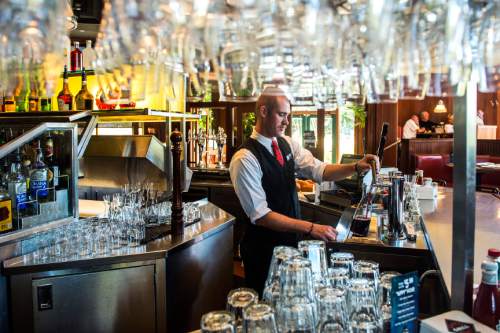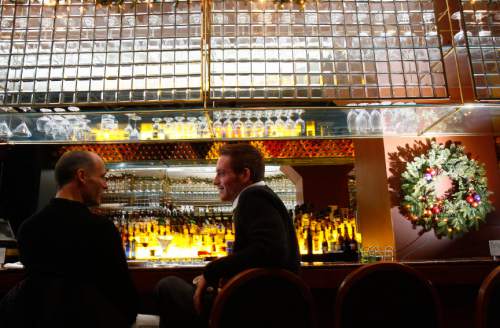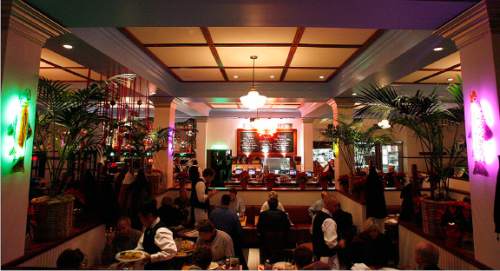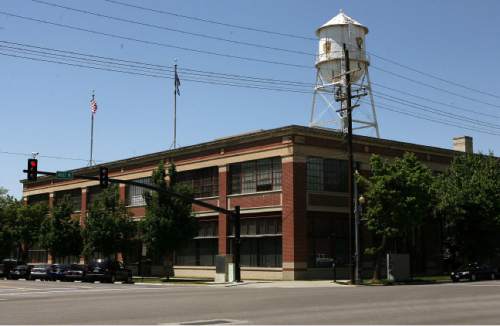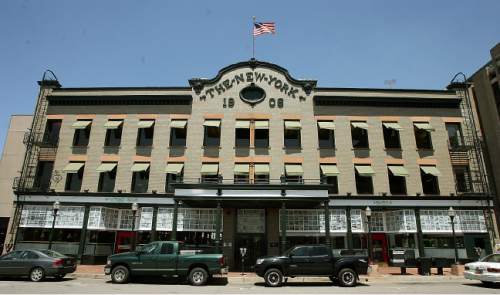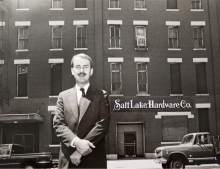This is an archived article that was published on sltrib.com in 2016, and information in the article may be outdated. It is provided only for personal research purposes and may not be reprinted.
Prominent restaurateur John Williams brought grace, style and a sharp eye for design to Salt Lake City's dining scene and made indelible marks on its skyline and arts community, those who knew him said.
Friends and associates expressed shock and deep sadness Monday at the death of the well-known co-founder of Utah's popular Gastronomy chain and restoration developer of historic landmarks such as Salt Lake Hardware and the Ford Motor Co. Building.
Williams, 72, died early Sunday amid a fire at his Capitol Hill home. Police have ruled the death suspicious, and Williams' estranged husband, Craig Crawford, 47, was being held on charges of aggravated homicide and aggravated arson.
Gastronomy spokesman John Becker said Monday "the outpouring of grief and love for John Williams is greatly appreciated by the company."
Williams, Becker said, "made an enormous contribution to the vitality and growth of Utah, transforming the dining habits and the appearance of downtown."
Many remembered the businessman as personable, unassuming, loyal, charismatic and unabashedly enthusiastic about food, ideas, and his projects and businesses — an entrepreneur and charitable donor for nearly four decades who often got things done behind the scenes.
Mayor Jackie Biskupski said Monday that she was devastated by the news of his passing, describing Williams as "a dear friend" who cared deeply about Salt Lake City.
"There are patrons of the arts, sciences and education, but John Williams was a patron of our city and helped it become the wonderful place it is today," Biskupski said in a statement. "While I have lost my friend, we all have lost a local hero."
State Sen. Jim Dabakis called Williams "a quiet ambassador for the LGBT community for his whole life," including in the 1970s and '80s when, the Salt Lake City Democrat said, "John was the first gay person many of these leaders had ever met."
"He was responsible for opening many minds," Dabakis said. "Everyone loved and respected him."
A native of Franklin, Idaho, Williams studied at Utah State University and the University of Utah before combining two lifelong interests with the 1978 debut of his first restaurant, The New Yorker. Having admired the run-down New York Hotel from his residence at the adjacent Shubrick Apartments, a friend said, Williams decided to renovate it and open an eatery featuring fresh seafood.
Encouraged by The New Yorker's near-immediate success, Williams and business partners Tom Sieg and Tom Guinney launched the Market Street Grill and Market Street Oyster Bar in the same building, with ocean fare flown in daily under a special arrangement with Delta Air Lines.
Market Street would eventually open additional locations in South Jordan and Cottonwood Heights as part of a roster of seven Gastronomy restaurants now in operation.
Williams hired Scott Beck out of college in 1987 to work at Cafe Pierpont, where Beck said his boss regarded dining as a full experience meant to stimulate all the senses. Gastronomy establishments focused on ambiance and usually featured pieces of locally produced art, be they gorgeous canvases, stained-glass windows or hand-painted columns.
"He had impeccable taste and vision unlike anyone I've ever worked with," said Beck, now president and CEO of Visit Salt Lake. "Our current restaurant culture owes its credibility to what they built."
The Utah Restaurant Association will honor Williams on Tuesday evening at its annual awards ceremony. The association's president and CEO, Melva Sine, said few people have so burnished Salt Lake City's image as a dining destination and had such an impact across generations. Many notable up-and-coming restaurateurs, chefs and other experts in Utah, she said, can trace their starts to Gastronomy and Williams' mentorship.
"John's legacy is in the heart of our community," Sine said. "That's going to be with us for a long time."
Williams hired Wendy Caron in 2002 as Gastronomy's first director of wine, which was a new post in the world of Utah hospitality. Caron said he was gracious, smart and generous, with a knack for recognizing appealing trends.
"He was a visionary, whether with people, concepts, spaces, restaurants," said Caron, who became director of operations at the elegant La Caille restaurant in Sandy and is now an industry consultant.
Williams also is credited with saving notable historic buildings in Salt Lake City from demolition, often spending millions to turn them into innovative and hip restaurants or office spaces.
His success as a developer and commitment to historic preservation "shaped the way downtown has developed," said Jason Mathis, executive director of the Downtown Alliance.
Those stylish sensibilities extended to a fluency with architectural ideas and unconventional ways of creating well-lit and energized gathering spaces, said Jeff Gochnour, project director on the Salt Lake Hardware Building renovation, completed in 1996.
"He could see things that nobody else could see," said Gochnour, who recalled Williams frequently returning from his latest world travels with new experiments to try.
Often, when told by a fire inspector, designer or architect that his flourishes wouldn't work, Gochnour said, "John would have nothing of it."
According to Kirk Huffaker, executive director of Utah Heritage Foundation, Williams also had a marked influence on scores of commercial real estate agents and developers "who grew up respecting what he was doing."
"Gastronomy defined what adaptive use means for Utahns," Huffaker said. "He liked places of character."
Twitter: @TonySemerad




